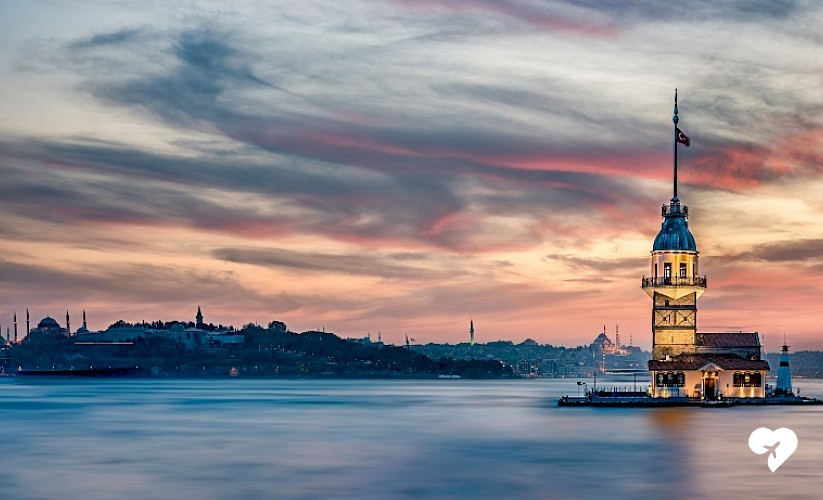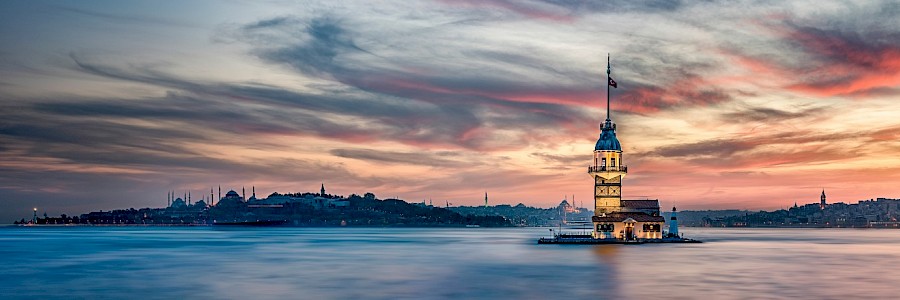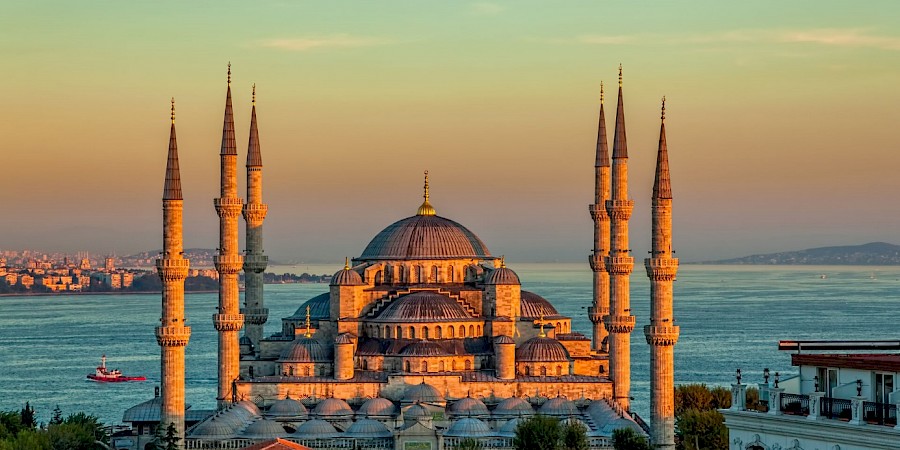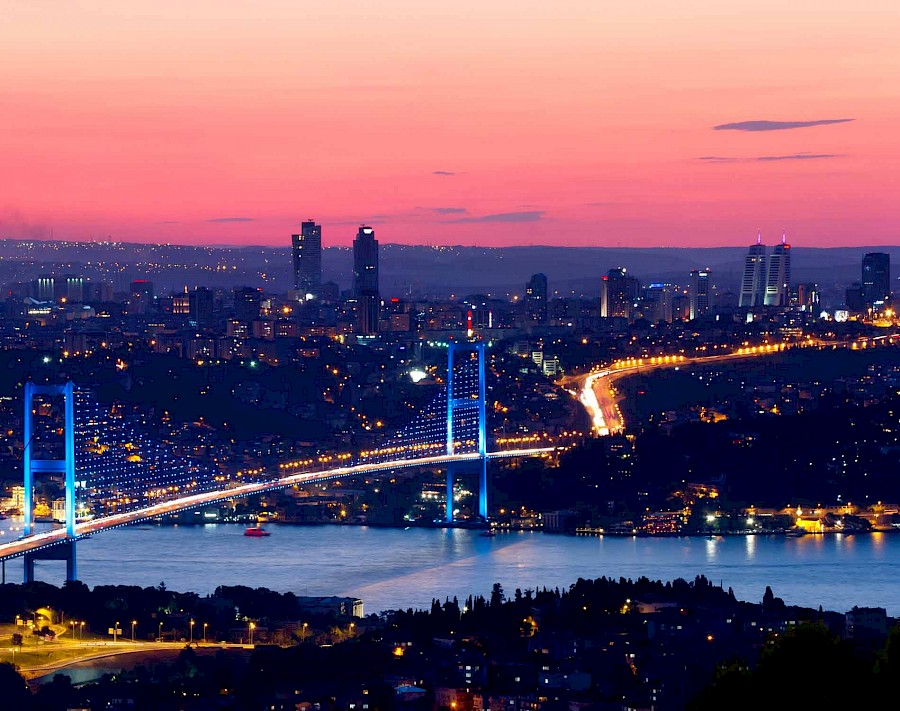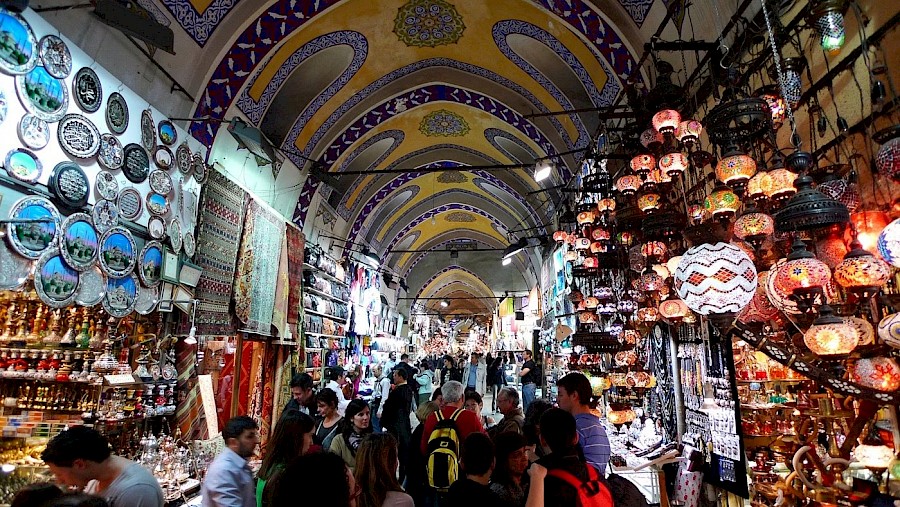For more than 1500 years İstanbul was the capital of Roman, Byzantine and Ottoman Empires.
With one arm reaching out to Asia and the other to Europe, İstanbul is the only city in the world built on two continents. The Bosphorus courses the waters of the Black Sea, the Sea of Marmara and the Golden Horn through the city’s heart.
İstanbul's fate has been sealed by its vital strategic location and its enchanting natural beauty. For more than 1500 years it was the capital of three empires: Roman, Byzantine and the Ottoman Empires. It was beautified accordingly with magnificent monuments and became a metropolis where diverse cultures, nations and religions mingled. Those cultures, nations and religions are the small pieces that form the mosaic of İstanbul.
İstanbul’s most important building works started in the Byzantine period and the city was then embellished further during the days of the Ottoman Empire.
Modern and Traditional Together
It is İstanbul's endless variety that fascinates its visitors. The museums, churches, palaces, grand mosques, bazaars and sites of natural beauty are countless. As relaxing on the western shores of the Bosphorus at sunset and watching the red evening light reflected on the other continent, you may suddenly and profoundly understand why so many centuries ago settlers chose to build a city on this remarkable site. At such times you can see why İstanbul is truly one of the most glorious cities in the world.
İstanbul is Turkey's most developed and largest city, with the latest discoveries indicating that the history of human habitation there goes back some 400,000 years. The purple years of İstanbul may have started in 330 when Emperor Constantine declared the city the capital of his empire – royal purple is the colour of the Byzantine imperial family. Until 1453, when it was conquered by the Ottomans, the city served as the capital of the Byzantine Empire. During the reign of the Byzantines, İstanbul was adorned with a number of great monuments, which made it the most magnificent city in the world, even during the declining years of the empire.
Striking Multireligious Identity
The identity of İstanbul that began with the Byzantines was further shaped during the period of the Ottoman Empire. Sultan Mehmet the Conqueror declared İstanbul the capital of Ottoman Empire after he conquered the city in 1453. Over the next 450 years the city was adorned with superb Ottoman monuments. Building works after the conquest gathered apace during the reign of Sultan Bayezid II, with the finest works built by Mimar Sinan, the Chief Royal Architect. This worldfamous architect put his signature on the silhouette of İstanbul with a number of masterpieces.
The Ottomans were tolerant towards all religions and dedicated many places of worship to the Christian and Jewish communities so that these peoples could practise their religion undisturbed. Thus, in İstanbul mosques, churches and synagogues stood and still stand side by side as the physical evidence of İstanbul and a symbol of tolerance and fraternity of religions.
GLORIOUS TREASURES
As an imperial capital of 1500 years, İstanbul is rich in architectural monuments reflecting its past splendour.
At every turn in the city one can happen upon Roman, Byzantine and Ottoman palaces, mosques, churches, monasteries, monuments, walls and ruins. The old city centre, with its places of worship, government, trade and entertainment, was where the citizens mingled, enjoying the benefits of the security and bounty of the state while maintaining their culture and way of life.
The most magnificent of İstanbul’s monuments are clustered on the historical peninsula, the triangular piece of land surrounded by the Sea of Marmara to the east and south, by the Golden Horn to the north and by the city walls to the west. The Historic Areas of İstanbul was inscribed on the World Heritage List of UNESCO in 1985, enchanting visitors with an impressive texture. Sultanahmet Square is the core of the historical peninsula and the most prominent examples of Byzantine and Ottoman architecture can be seen in close proximity here.
Living Heritages of Byzantines
During the Byzantine Period the centre of the city was the Hippodrome and its environs. The Palace was the centre of power, the Hagia Sophia (Ayasofya) the most spectacular of the religious buildings; the Hippodrome served as the common entertainment centre and the Yerebatan Sarnıcı (Basilica Cistern) supplied most of the city’s water, – all are to be found at the centre of the city. During Ottoman times, the square where the Hippodrome once stood became the site for the circumcision ceremonies of the Sultans’ sons.
Great Mystic Symbols
The most glorious architectural heritage of the Byzantine Empire is the Hagia Sophia which is referred to as the 8th Wonder of the World. Aged more than 1500 years old, it is one of the great symbols of İstanbul. The mosaics of Hagia Sophia, which were uncovered after it became a museum, are the foremost examples of Byzantine art of the 9th to 12th centuries. The Kariye Museum (Chora Church) is another Byzantine monument famous for its fine mosaics and frescoes. The Neve Shalom, Ahrida and Aşkenazi synagogues are three of the most important sacred places for Judaism in İstanbul.
The Topkapı Palace is particularly important for the Mukaddes Emanetler Dairesi (Chamber of Holy Relics) where the Prophet Muhammed’s Hırka-i Saadet (Blessed Mantle) and Sancak-ı Şerif (Holy Banner) are kept in their golden chests. The Sultan Ahmet Mosque, also known as the Blue Mosque, was built between 1609 and 1616 and houses the tomb of its founder, Sultan Ahmed I, a madrasah and a hospice.
The Other Shore
Another historical area of İstanbul, on the opposite shore of the Golden Horn, is the former district of Pera, meaning ’the other shore’. Settled by Genoese and Venetians in the 12th century, this quarter was inhabited mostly by Levantines and represented the western face of the city. The cosmopolitan character of ancient İstanbul is reflected in the following buildings there: the Galata Tower built by the Genoese, stately consulates which were embassies before the capital was moved to Ankara, and the art nouveau buildings of İstiklal Avenue. St Antoine Cathedral, a silent and tranquil spot on this avenue, is visited frequently by devout visitors from every religion. Palaces, summer palaces, castles and large mansions built by the Ottomans continue to adorn İstanbul. The Yıldız Palace and the Dolmabahçe on the shores of the Bosphorus were once the residences of the Ottoman Sultans, after Topkapı Palace. İstanbul is also famous for the elegant wooden houses, the yalı, built along the shores of the strait.
THE NEW İSTANBUL
Building on its assets inherited from a glorious past, İstanbul is an international city with a financial and economic centre offering services in banking, telecommunications, marketing, engineering and tourism.
International conferences and festivals, fairs, fashion shows, sports and art performances give a new dimension to the life and potential of the city.
İstanbul is one of the busiest centres of 'congress travel' in the world, offering every support and service to conferences of all sizes. Great service is available due to İstanbul’s excellent transportation and communication facilities and a wide choice of accommodation equipped with the latest technology.
THE BOSPHORUS
A stay in İstanbul is not complete without a traditional and unforgettable boat excursion up the Bosphorus, the strait that separates Europe and Asia. Its shores offer a delightful mixture of past and present, grand splendour and simple beauty.
Modern hotels stand next to yalı (waterfront wooden villas); marble palaces abut on rustic stone fortresses and elegant compounds neighbour small fishing villages.
The best way to see the Bosphorus is to board one of the passenger boats that regularly zigzag along the shores. Embark at Eminönü and stop alternately on the Asian and European sides of the strait! The round-trip excursion, very reasonably priced, takes about six hours. For those who want a private voyage, there are agencies that specialize in organizing day or night-time mini-cruises.
During the trip you will go past the magnificent Dolmabahçe Palace, while further along rise the green parks and imperial pavilions of the Yıldız Palace. To the waterfront of the parks stands the Çırağan Palace, refurbished in 1874 by Sultan Abdülaziz, and now restored as a grand hotel. For 300m along the Bosphorus shore, its ornate marble facades reflect the swiftly moving water. At Ortaköy, the next stop, every Sunday artists gather to exhibit their works in a streetside gallery with the variety of people creating a lively scene. Sample a tasty kumpir (baked potato) from one of the street vendors. And note its church, mosque and synagogue that have existed side by side for hundreds of years – a tribute to Turkey’s tolerance at the grass-roots level. Overshadowing İstanbul’s traditional architecture at Ortaköy is one of the world’s largest suspension bridges, the Boğaziçi Bridge, linking Europe and Asia.
Shore Excursion
The beautiful Beylerbeyi Palace lies just past the bridge on the Asian side and behind the palace rises Çamlıca Hill, the highest point in İstanbul. You can also drive here to admire the magnificent panorama of İstanbul as well as the beautiful landscaped gardens. On the opposite shore, the wooden Ottoman villas of Arnavutköy create a contrast with the luxurious modern apartments of neighbouring Bebek. A few kilometres further along stand the fortresses of Rumeli Hisarı (Rumelian Fortress) and Anadolu Hisarı (Anatolian Fortress) facing each other across the straits like watchful protectors. The Göksu Palace, sometimes known as Küçüksu Palace, graces the Asian shore next to Anadolu Hisarı. As the second link between the two continents, the Fatih Sultan Mehmet Bridge straddles the waterway just past these two fortresses.
From Duatepe Hill on the European side you can wonder at the magnificent panorama of the bridge and the Bosphorus. Below Duatepe, beautiful Emirgan Park bursts with colour when its tulips bloom in the spring. On the Asian shore is Kanlıca, a fishing village that is now a favoured suburb for wealthy İstanbul residents; crowds gather in the restaurants and cafes along its shores to sample its famous yogurt. Shortly after Kanlıca and Çubuklu is the Beykoz Korusu (İbrahim Paşa Woods), a popular retreat – in the cafes and restaurants there you can enjoy the delightful scenery and clean, fresh air. Back on the European side, at Tarabya Bay, yachts seem to dance at the moorings. The coastal road then bustles with taverns and fish restaurants from Tarabya to the charming suburbs of Sarıyer and Büyükdere. Sarıyer has one of the largest fish markets in İstanbul and is also famous for its delicious varieties of milk puddings and börek (pastries). After Sarıyer, the narrow strait widens and opens into the Black Sea.
THE GOLDEN HORN "HALİÇ"
This horn-shaped estuary known as the Golden Horn divides European İstanbul into two. As one of the best natural harbours in the world, the Byzantine and Ottoman navies and their commercial shipping interests were centred here. Today, lovely parks and promenades line the shores where the setting sun casts a golden hue on the water. At Fener and Balat, neighbourhoods midway up to the Golden Horn, whole streets full of old wooden houses, churches and synagogues date from Byzantine and Ottoman times, while the Orthodox Patriarchy resides at Fener. Eyüp, a little further up, is full of Ottoman architecture, much of it restored, and cemeteries dotted with dark cypress trees covering the hillsides. Many believers come to the Tomb of Eyüp in the hope that their prayers will be granted. The Pierre Loti Cafe, atop the hill overlooking the shrine, is a wonderful place to enjoy an alternative view of İstanbul.
ARTS, CULTURE and ENTERTAINMENT
İstanbul is an international centre for arts and culture with a rich tradition in opera and ballet, theatres performing both Turkish and international works, concerts, exhibitions, festivals, auctions, conferences and, of course, museums.
İstanbul’s private museums, which opened one after the other in the early 2000s, have hosted exhibitions featuring the world’s finest masterpieces.
İstanbul Modern offers a permanent collection of modern art, as well as temporary exhibits, featuring many of the most famous Turkish painters. Santralİstanbul offers not only artistic and cultural activities but also aims to become an interdisciplinary, international platform contributing to the creation of an environment fostering intercultural dialog and debate. Contemporary İstanbul is the only international fair for the contemporary art in Turkey. Organized every year, the fair is a meeting place for art-lovers, collectors, art galleries and artists from all over the world. The most prestigious of the city’s international cultural events are the international festivals organised by the İstanbul Foundation for Culture and Arts, including in their programs the finest examples of artistic creativity in the fields of classical music, ballet, modern dance, opera, folklore, jazz/pop, cinema, drama and visual arts from both Turkey and abroad as well as seminars, conferences and lectures.
Splendid Entertainment
İstanbul also has a rich program of entertainment; bars, pubs, nightclubs and discos are plentiful and there are countless restaurants offering Turkish cuisine with all its local varieties, not to mention the Italian, French, Japanese, Chinese and Lebanese cuisine.
The meyhanes, literally 'wine houses', are a special experience and where the main drink served is not so much the wine but rakı, an alcoholic beverage made of grapes and anise. Nightclubs provide splendid entertainment throughout dinner, ranging from a selection of Turkish songs to belly-dancing. There are also modern discos, cabaret and jazz clubs in the Taksim-Harbiye district. In Sultanahmet there are a number of restaurants set in restored Byzantine and Ottoman premises which offer a unique setting for an evening out.
Kumkapı is another attractive district with its many taverns, bars and fish restaurants. People have been meeting for years at Çiçek Pasajı in Beyoğlu for snacks and seafood specialties and nearby is narrow Nevizade Street- the best place in İstanbul for eating Turkish specialties and drinking rakı.
On the shores of the Bosphorus, Ortaköy is the best place for nightlife in İstanbul with its nightclubs, jazz clubs, fine seafood restaurants and bars. At Eminönü, don’t miss the opportunity to see the fishermen dressed in traditional Ottoman clothes serving fried fish from their Ottoman-style boats.
SHOPPING
İstanbul is a shopper’s paradise, catering to all kinds of customers. From covered bazaars and workshops that continue ancient traditions, to shopping malls and department stores, İstanbul offers a wide variety of shopping opportunities.
Kapalı Çarşı (Grand Bazaar) and Mısır Çarşısı (Spice Bazaar) are the two most visited places in İstanbul. Kapalı Çarşı has evolved into its present form over a period of 250 years, and today sells everything from antiques to jewellery, from gold to affordable souvenirs in over 3000 shops. Its original function determined by Sultan Mehmet the Conqueror was to generate income for the upkeep of the Ayasofya (Hagia Sophia). Mısır Çarşısı was opened with a similar aim of supporting Yeni Cami (New Mosque). Today both Kapalı Çarşı and Mısır Çarşısı are places for finding plenty alternatives for souvenirs and mementos of İstanbul. As both were once primary trading places during the Ottoman Period, today some traditional wares can still be found there. Arasta Çarşısı (Arasta Bazaar), situated behind the Sultan Ahmet Mosque, is yet another place where authentic goods and handicrafts can be found and Sultanahmet and its environs are other similar areas. Old book enthusiasts should visit the Sahaflar Çarşısı (Booksellers’ Market), which is situated between Beyazıt Mosque and Kapalı Çarşı.
Hub of Top Brands
The sophisticated shops of the Taksim – Nişantaşı neighbourhoods provide a contrast to the chaos of the bazaars. On İstiklal, Cumhuriyet and Rumeli avenues, for example, one can browse at leisure the shops selling special pieces such as home-grown designer products and top international designer brands. Exquisite jewellery, finely designed handbags and shoes can also be found here.
For those who do not want to spend too much time wandering in the streets while shopping, there are a number of shopping malls that bring many brands and types of goods under one roof. These malls host not only top fashion stores but also furniture shops and shops selling household goods as well as cafes, restaurants and food courts. Some malls even have cinemas and places to entertain children.
İSTANBUL'S ENVIRONS
The Princes’ Islands, an archipelago of nine islands in the Sea of Marmara, were places of exile for Byzantine princes. Today, during the summer months, İstanbul residents escape to those islands’ cool sea breezes and elegant 19th-century houses.
Büyükada is the largest of the islands where you can enjoy a ride in a horsedrawn phaeton among the pine trees or relax on a beach in one of the numerous coves that ring the island. The other popular islands are Kınalı, Sedef, Burgaz and Heybeliada. Regular ferryboats connect the islands with both the European and Asian shores and a faster sea bus service operates from Kabataş in the summer.
Superb Spots for All
On the European side of the Black Sea coast, 25km from the outskirts of İstanbul, the long, broad sandy beaches of Kilyos draw crowds of İstanbul residents in the summer. The Belgrade Forest, inland from the Black Sea on the European side, is the largest forest around İstanbul; on weekends İstanbul residents drive out to this place for family picnics and barbecues in the coolness of its shade. Seven ancient reservoirs and a number of natural springs refresh the air while its Ottoman aqueducts, of which the 16th-century Moğlova Aqueduct built by Sinan is the most splendid, lend majesty to the natural surroundings. On the Asian side, Polonezköy, 25km from İstanbul, was founded by Polish immigrants in the 19th century. İstanbul residents come to Polonezköy’s pastoral landscape for walks and horse riding and to enjoy the traditional Polish food served by descendants of the original settlers. On the Black Sea coast, 70km from Üsküdar, Şile’s sandy beaches, fish restaurants and hotels make it one of the most delightful holiday places near İstanbul. Cool cotton clothing called Şile bezi is popular with tourists and is fashioned here.
Places to Unwind
Bayramoğlu-Darıca Bird’s Paradise and Botanic Park, 38 km from İstanbul, is a unique place to relax. Many species of birds and plants from all over the world can be seen in this huge park, which also has restaurants and a promenade for pedestrians.
The charming fishing town of Eskihisar, on the southeast of İstanbul, boasts a marina where yachtsmen moor their boats after a day of sailing on the Sea of Marmara. In the town, the house of Osman Hamdi Bey, Turkey’s great 19th-century painter, was made into a museum. Neighbouring sites include the tomb of Hannibal between Eskihisar and Gebze and a Byzantine castle.
Many İstanbul residents have summer houses near Silivri, a popular vacation area about 65km from İstanbul. As a large holiday resort town, it offers sports, health and fitness facilities, while the conference centre attracts business people who want to escape the city’s fast pace for a working holiday. A regular sea bus service connects İstanbul to Silivri.
